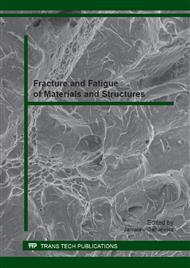[1]
A. Zieliński, J. Ćwiek, S. Rymkiewicz, W. Serbiński Investigations and modeling of material degradation under influence of action of mechanical and corrosion factors,, Problems of Eksploitation, 4 (2003) 29-36 (in Polish).
Google Scholar
[2]
Nandan R., DebRoy T., Bhadeshia H.K., Recent Advances in friction stir welding – process, weldment, structure and properties, Progress in Materials Science, 53 (2008) 980-1023.
DOI: 10.1016/j.pmatsci.2008.05.001
Google Scholar
[3]
D. Kocańda, A. Górka, New techniques for ,friction stir welding of materials, Bull. WAT, 2, (2010) 395-411 (in Polish).
Google Scholar
[4]
C.S. Paglia, R.G. Buchheit, A look in the corrosion of aluminium alloy friction stir welds, Scrypta Materialia, 58 (2008) 383-387.
DOI: 10.1016/j.scriptamat.2007.10.043
Google Scholar
[5]
R.S. Mishra, Z. Y. Ma, Friction stir welding and processing, J. Mater. Sci. Engng, 50, (2005) 1-78.
Google Scholar
[6]
C. Hamilton, S. Dymek, O. Senkov, Thermal modeling of friction stir welding of Sc-modified Al-Zn-Mg-Zu alloy, Computer Methods in Materials Science , 9 (2009) 416-423.
DOI: 10.1002/9781118062302.ch17
Google Scholar
[7]
I. Kalemba, S. Dymek, C. Hamilton, M. Wróbel, M. Blicharski, Exfoliation corrosion behavior of friction stir welded AA7136-T76 extrusions. Kovove Mater. 47 (2009) 101-107
DOI: 10.1007/978-3-319-48173-9_12
Google Scholar
[8]
Zhou C., Yang X., Luan G., Investigation of microstructures and fatigue properties of friction stir welded Al-Mg alloy, Materials Chemistry and Physics, 98 (2006) 285-290.
DOI: 10.1016/j.matchemphys.2005.09.019
Google Scholar
[9]
Zeng R-C., Chen J., Dietzel W., Zettler R., et al., Corrosion of friction stir welded magnesium alloy AM50, Corrosion Science, 51 (2009) 1738-1746.
DOI: 10.1016/j.corsci.2009.04.031
Google Scholar
[10]
S.Y. Liu, J.D. Hu, Y. Yang, Z.X. Guo, H.Y. Wang, Microstructure analysis of magnesium alloy melted by laser irradiation. Applied Surface Science, 252 (2005) 1723-1731.
DOI: 10.1016/j.apsusc.2005.03.110
Google Scholar
[11]
Marrow T.J., King J.E., Microstructural and environmental effect on fatigue crack propagation in duplex stainless steel, J. Fatigue a. Fract. Mat. Struct. 17 (1994) 761-771.
DOI: 10.1111/j.1460-2695.1994.tb00807.x
Google Scholar
[12]
Cui L., Fuji H., Tsuji N., Nogi K., Friction stir welding of a high carbon steel, Scripta Materialia, Vol. 56, 2007, pp.637-640.
DOI: 10.1016/j.scriptamat.2006.12.004
Google Scholar
[13]
H.K.D.H. Bhadeshia, T. DebRoy, Crittical assessment: friction stir welding of steels. Science and Technology of Joining, 14 2009 193-186
DOI: 10.1179/136217109x421300
Google Scholar
[14]
Project PBG nr N N501 0097 33 "Estimation of the influence of surface frictional-mechanical treatment of hull steel on its exploitative properties in corrosive environmental. Warsaw, MUT, 2011.
Google Scholar
[15]
D. Kocańda, H. Nykyforchyn, J. Torzewski, W. Jurczak, K. Świątek, Exploitative properties of a low alloyed steel after surface frictional-mechanical treatment in see water environmental. XIII Conf. Fracture Mechanics, Opole, 2011.
Google Scholar
[16]
D. Kocańda, V. Hutsaylyuk, T. Ślęzak T., J. Torzewski, H. Nykyforchyn, V. Kyryliv, Fatigue crack growth rates of S235 and S355 steels after friction stir processing, J. Materials Science Forum (2012) 203-210.
DOI: 10.4028/www.scientific.net/msf.726.203
Google Scholar


